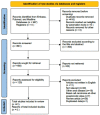Perianal Basal Cell Carcinoma-A Systematic Review and Meta-Analysis of Real-World Data
- PMID: 37175041
- PMCID: PMC10178443
- DOI: 10.3390/diagnostics13091650
Perianal Basal Cell Carcinoma-A Systematic Review and Meta-Analysis of Real-World Data
Abstract
(1) Background: BCC is a sporadic disease that develops in areas of the skin not exposed to the sun. Perianal BCC, which occurs in the anorectal region, accounts for less than 0.2% of all BCC cases. There have been only a few reported cases of the disease, with fewer than 200 cases reported in total. Given the diagnostic challenges and potential for misdiagnosis, we conducted a systematic review of perianal basal cell carcinoma using real-world data to provide comprehensive and detailed information on the disease. (2) Methods: The study was reported based on the Preferred Reporting Items for Systematic Reviews and Meta-Analyses (PRISMA) guidelines, 2020. Patients' clinical pathologic features, tumor characteristics, treatment modalities, and outcomes were presented. (3) Results: The results of 41 studies involving 140 patients were analyzed. The most common symptoms reported by patients at presentation were anorectal bleeding, pain, and pruritus. Ulceration was the most frequently observed tumor characteristic. The majority of patients underwent local excision as their primary treatment, with only eight patients experiencing a recurrence. Our analysis did not reveal any statistically significant differences in the outcomes of different treatment modalities. (4) Conclusions: Identifying perianal BCC poses a significant challenge as it closely resembles other anal diseases, thereby making it difficult to differentiate between the different conditions. However, a wide local excision with clear margins is considered an effective treatment option for most patients. Alternative treatments, such as radiotherapy, may be recommended for patients who are unable to undergo surgery.
Keywords: anal malignancy; diagnosis; oncologic outcome; perianal basal cell carcinoma; systematic review.
Conflict of interest statement
The authors declare no conflict of interest.
Figures




References
Publication types
LinkOut - more resources
Full Text Sources

